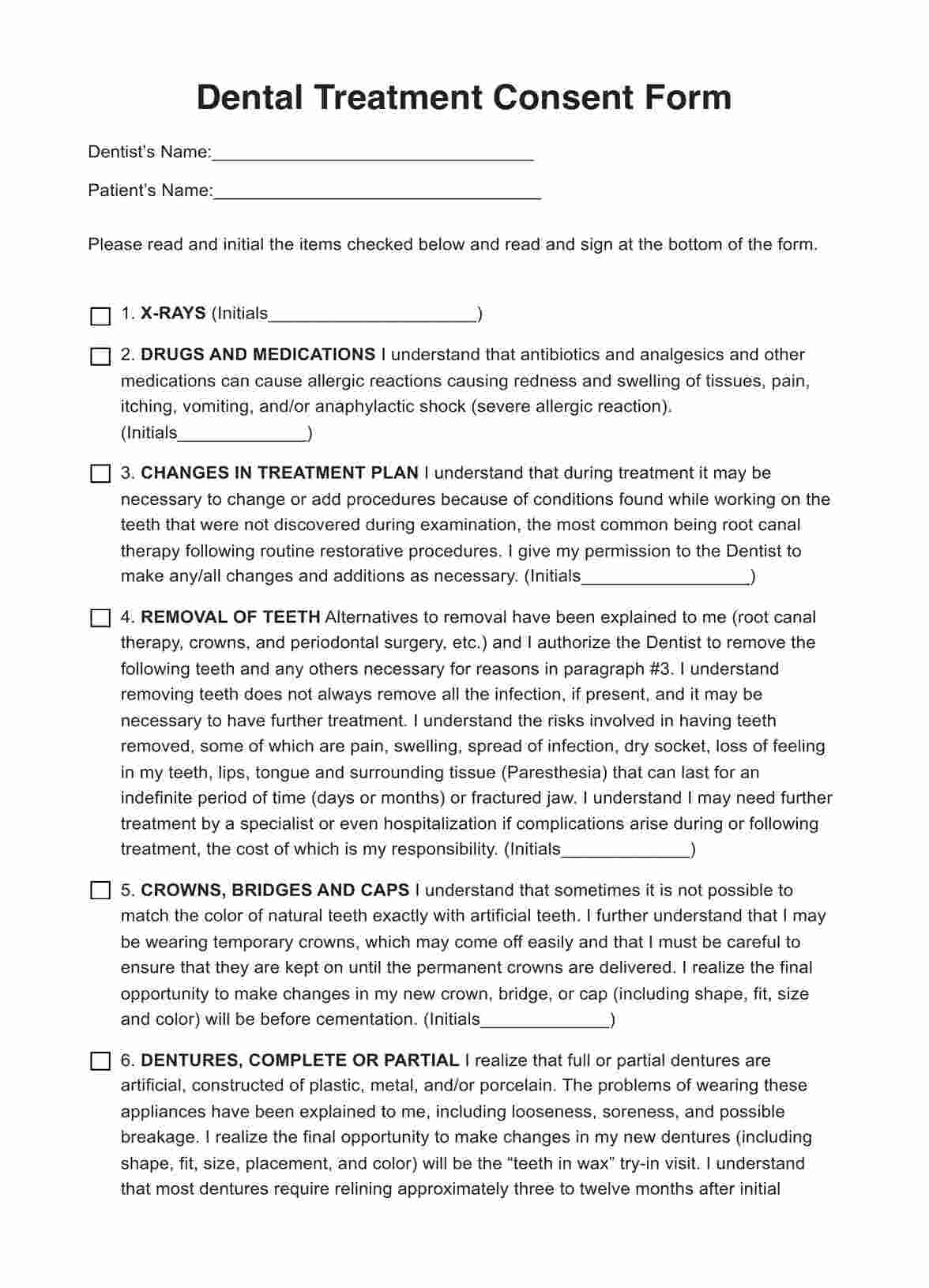
Discover a Dental Treatment Consent Form and its importance in dental practices. Download our free PDF today!

By Audrey Liz Perez on Jul 15, 2024.


A dental treatment consent form is a document used in dental practices to inform patients about a specific dental procedure and to obtain their consent to proceed with the treatment. The key elements of a dental consent form typically include:
The form serves several important functions. It helps ensure that the patient is fully informed about the treatment they will receive, which is a key aspect of patient rights and medical ethics. It also serves as a legal document that can protect the dental practitioner in case of disputes about the patient's consent or the information provided. Consent forms are a standard part of most medical and dental procedures and are considered an essential best practice in healthcare.
PDF Template Example PDF

Understanding the functioning of a Dental Treatment Consent Form requires a deep dive into the stages and significance of the consent process.
Before the dental treatment begins, the dentist will present the patient with the Dental Treatment Consent Form. This step ensures the patient knows what to expect, why the procedure is necessary, the associated risks, and the potential outcomes.
The patient and dentist, or other qualified dental staff, review the form together. Every aspect of the treatment is covered, and patients are encouraged to ask questions. This stage builds a strong foundation for trust and collaboration, ensuring the patient's needs and concerns are addressed.
After a thorough review, the patient initials specific sections and signs the form, signaling understanding and agreement with the treatment. This step is vital in legally documenting the patient's informed consent and willingness to proceed.
The signed consent form becomes a permanent part of the patient's medical record summary. It references future treatments and legal evidence for a dispute regarding the care provided.
A Dental Treatment Consent Form is a legal requirement and ethical necessity, serving as a critical component in various dental care scenarios. Its application is broad and multifaceted, encompassing more than just significant surgeries.
The form manifests the principle of informed consent, ensuring that patients have adequate information about their dental treatments. Whether it's a routine check-up or a complex surgical procedure, the Dental Treatment Consent Form documents the patient's understanding and acceptance of the treatment plan.
It's not just a formality but a commitment to patient autonomy, clear communication, and legal protection.
Even for standard procedures like teeth cleaning or filling cavities, patients are informed about the processes involved, and their consent is taken. These documents may sometimes be presented more concisely, but the principle remains the same.
Detailed consent forms are required for more complex treatments such as extractions, implants, or root canal therapy. These documents provide in-depth information on the procedure, potential risks, and alternatives.
When treating minors, consent from a parent or guardian is necessary. Specific consent forms tailored to children's needs and comprehension levels are often used.
In cases where the patient decides not to proceed with the recommended treatment, a refusal of the dental treatment consent form is utilized. This document protects both the patient's right to decline treatment and the dental provider's professional position.
The Dental Treatment Consent Form is a vital tool that transcends mere legality, conferring several significant benefits to both the patient and the dental provider.
The utilization of Dental Treatment Consent Forms is far-reaching, offering a robust framework for patient-centered care, clear communication, legal compliance, and more. The benefits are not confined to safeguarding professional interests but extend to enhancing the overall quality of dental care.
Here's a closer look at why these forms are indispensable:
By explaining the treatment in detail, the form enables patients to make informed decisions about their dental care. It promotes a sense of ownership and confidence in the treatment process.
The form initiates a dialogue between the dentist and the patient, fostering a relationship of trust and understanding. It ensures that the patient's concerns are addressed and that the dentist understands their expectations.
From a legal standpoint, the consent form records that the patient was adequately informed and voluntarily agreed to the treatment. It offers protection against potential legal challenges.
Utilizing the form adheres to ethical guidelines and professional standards, reflecting the dental provider's commitment to transparency, honesty, and patient welfare.
The consent form helps plan the treatment more effectively by clearly outlining the procedure. It acts as a reference guide for patients and providers, ensuring everyone knows what to expect, thus making the process smoother and more efficient.
The history of Dental Treatment Consent Forms stems from the broader medical ethics field, emphasizing patient autonomy and informed consent. Various studies and legal precedents highlight the form's necessity in promoting patient rights and protecting dental practitioners. Informed consent in dentistry has been reinforced through regulatory guidelines and standards, reflecting a global consensus on the importance of patient awareness and agreement.
Research shows that a properly administered dental treatment consent form enhances the patient's satisfaction and adherence to the treatment plan, thus improving overall outcomes. Evidence suggests that such forms can also play a crucial role in medico-legal disputes, often serving as vital documents in legal proceedings.